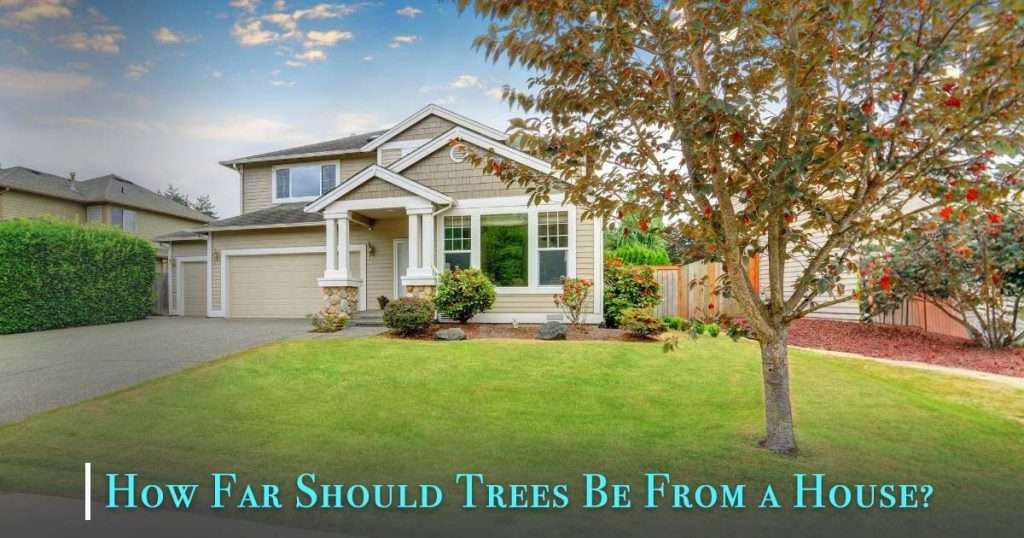Caring for plants and trees brings a lot of joy and seems to be a natural part of who we are. Spending time around greenery can really help improve our mental health by reducing stress and making us happier. A study from the University of Exeter even showed that living close to green spaces can make us feel better and lower the chance of mental health problems. Besides helping us personally, being close to nature is good for the planet too, as it cleans the air and supports various plants and animals.
Imagine having a garden full of fruit trees—it’s like having a little paradise at home. However, when planting trees in your garden, it’s important to plan carefully, especially about how close they are to your house.
Do You Really Need to Measure Distance When Planting Trees Near a House?
Yes, it’s important to keep a certain distance when planting trees near your house. This helps protect both your home and the trees. If trees are too close, several problems can happen, which might lead to expensive fixes.
Here’s why you should follow the distance rule:
- Roots Can Harm Foundations: Tree roots grow wide and strong. If they get too close, they might push against the house foundation, causing cracks or other damage.
- Branches Can Damage Roofs: Branches that hang over the roof can scratch and damage shingles and gutters. They can also drop leaves that clog gutters, causing water to overflow and potentially damaging the outside of your home.
- Trees Might Not Grow Well: Trees need room to grow properly. If they’re too close to the house, they might grow unevenly, leading to a lopsided and possibly unhealthy tree.
Planting trees at the proper spacing ensures their safety and healthy growth, as well as that of your house.
How Far Should Trees Be from Your House?
Deciding how far to plant trees from your house involves a few important things to consider. The right distance depends on the size of the tree, how its roots spread, and the type of tree. These factors help make sure your house stays safe and the tree grows well.
Things That Affect Planting Distance
- Tree Size: Bigger trees need more room. Their branches and roots can grow quite large, so planting them farther away from buildings helps prevent any damage.
- Root Spread: Some trees have roots that grow out widely. These roots can cause problems with foundations, pipes, and sidewalks if they’re too close. It’s important to think about root spread when picking a spot for your tree.
- Tree Type: The kind of tree also matters. Some trees are better suited to being planted near homes because of their size and how they grow.
Trees You Shouldn’t Plant Too Close to a House
- Large Trees: Trees like oaks, maples, and elms have big root systems and wide tops. It’s best to plant them at least 20-30 feet away from any building.
- Trees with Spreading Roots: Trees like willows and poplars have roots that spread a lot and should be kept away from houses and underground utilities.
Good Trees to Plant Near a House
- Ornamental Trees: Smaller trees such as dogwoods, redbuds, and Japanese maples are great for planting closer to homes. They usually have roots that are easy to manage and don’t grow too tall.
- Trees with Non-Spreading Roots: Trees like crabapples and some magnolias have roots that are less likely to cause problems with foundations or pipes.
You can enjoy having trees close to your house without having to worry about them getting damaged if you choose the right trees and plant them at a reasonable distance away.
Easy Planning for Planting Trees Around Your House
- Check the Space You Have: Look at the area where you want to plant trees. Think about how much room you have side to side and up high. Make sure your trees won’t be too close to buildings or power lines as they grow.
- Pick the Right Trees: Find trees that do well in your local weather and soil. Look for ones that don’t need a lot of water, resist pests, and grow at a manageable pace. Choose trees with roots that won’t mess up your house or pipes.
- Think About Future Size: Imagine how big the tree will get. Make sure it won’t be too close to your house, driveway, or other structures once it’s fully grown. This helps avoid issues like branches hitting the roof or roots cracking the pavement.
- Consider Effects on Your Home: Think about how trees will change things around your house. They can block sunlight or views and alter how wind moves around your home. Trees can help by giving shade in the summer and blocking wind in the winter.
- Check Your Soil: Test your soil to see what nutrients it has and its acidity. This helps you pick trees that will thrive or lets you know if you need to improve the soil first.
- Know Local Rules: Find out if there are any rules about planting trees in your area. Some places have specific guidelines on which trees you can plant and where you can plant them.
- Plan for Care: Think about how much care the trees will need, like watering, trimming, and keeping them healthy. Make sure you’re ready to take care of them for years to come.
In summary, planting trees around your home can make it more beautiful, provide shade, and benefit the environment. By following these simple steps, you create a green space that’s both lovely and lasting. Enjoy the process of making your home a more natural and peaceful place with the addition of trees.

